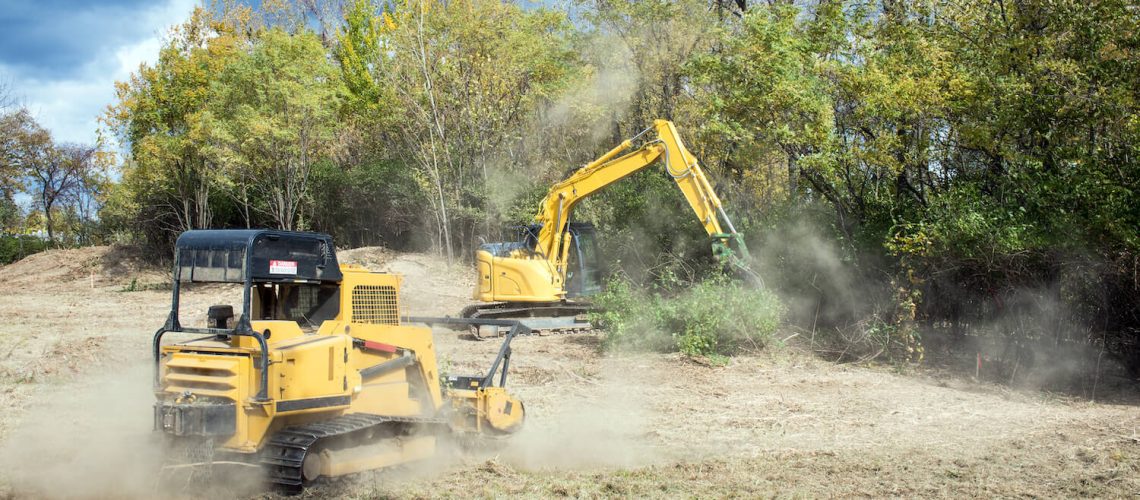Landscaping plays a pivotal role in shaping the aesthetics and functionality of any outdoor space. Whether you own a residential property, commercial space, or even an agricultural tract, the initial step in creating a vibrant and purposeful landscape often involves land clearing. This process is more than just removing vegetation and debris; it’s a transformative journey from overgrowth to oasis.
In this article, we’ll delve into the importance of land clearing, the methods involved, and the myriad benefits that come with a well-cleared landscape.
Understanding Land Clearing: The Why and How
Why is Land Clearing Necessary?
Land clearing is essential for several reasons, depending on the intended use of the space. In residential areas, it could be to make way for a new home, a garden, or simply to enhance the curb appeal. In commercial spaces, land clearing might be necessary for construction projects, parking lots, or other development purposes. In agriculture, it’s about creating arable land for cultivation.
Methods of Land Clearing
Land clearing involves various methods, each tailored to the specific needs of the project. Traditional methods include manual clearing with tools like chainsaws and machetes, while modern techniques incorporate heavy machinery such as bulldozers, excavators, and mulchers. The choice of method depends on factors like the size of the area, the type of vegetation, and the intended use of the land.
Benefits of Land Clearing: Cultivating an Oasis
Enhanced Aesthetics and Curb Appeal
One of the immediate benefits of land clearing is the visual transformation it brings to a property. Overgrown vegetation can make a space appear unkempt and uninviting. Clearing away the excess foliage allows for a fresh canvas on which to design a visually appealing landscape. This not only improves the aesthetics but also enhances the overall curb appeal of the property.
Increased Usable Space
Land clearing opens up space for various purposes. In residential areas, it can mean creating a larger backyard for recreation or gardening. In commercial settings, cleared land can be utilized for constructing new buildings, expanding parking areas, or creating outdoor recreational spaces. Agricultural land clearing, on the other hand, converts wild, untamed tracts into fertile grounds for cultivation.
Fire Prevention and Safety
Overgrown vegetation poses a significant fire hazard, especially in dry and hot climates. Land clearing acts as a preventative measure against wildfires by removing the excess vegetation that could serve as fuel. This is crucial not only for protecting the property itself but also for ensuring the safety of neighboring areas and communities.
Environmental Conservation and Biodiversity
While land clearing involves the removal of vegetation, it can be done in a way that promotes environmental conservation and biodiversity. Sustainable land clearing practices take into account the preservation of existing flora and fauna, ensuring that the ecosystem remains balanced. Additionally, cleared land can be repurposed for planting native species, contributing to the restoration of natural habitats.
Improved Soil Quality and Drainage
Overgrown vegetation can impact soil quality and hinder proper drainage. Land clearing allows for the assessment and improvement of soil conditions. It facilitates better water absorption, reducing the risk of waterlogging and erosion. In agriculture, this is particularly important as it creates an environment conducive to optimal crop growth.
Infrastructure Development
Land clearing is often a prerequisite for infrastructure development. Whether it’s laying the foundation for a new building, constructing roads, or installing utility lines, a cleared landscape provides a blank slate for these projects. This, in turn, contributes to the overall development and functionality of an area.
Challenges and Considerations in Land Clearing
Environmental Impact
While land clearing brings numerous benefits, it is not without its challenges, particularly concerning the environment. Indiscriminate clearing can lead to habitat destruction and the loss of biodiversity. It’s essential to approach land clearing with a mindset of environmental stewardship, using sustainable practices that minimize negative impacts.
Regulatory Compliance
Land clearing activities are often subject to regulations and permits. Understanding and complying with local and national laws is crucial to avoid legal complications. Working with environmental agencies and obtaining the necessary permits ensures that the clearing process aligns with established guidelines and standards.
Proper Waste Disposal
Land clearing generates a significant amount of waste, including vegetation, debris, and sometimes hazardous materials. Proper disposal methods are essential to prevent pollution and environmental harm. Recycling materials when possible and following established waste disposal protocols contribute to responsible land clearing practices.
The Future of Land Clearing: Sustainable Practices and Innovation
Sustainable Land Clearing Practices
The future of land clearing lies in embracing sustainable practices that balance development with environmental preservation. This includes selective clearing, where only necessary vegetation is removed, and reforestation efforts to offset any loss. Integrating technology and data-driven approaches can help optimize the land clearing process for minimal ecological impact.
Innovations in Machinery and Technology
Advancements in machinery and technology play a vital role in the evolution of land clearing. Modern equipment, equipped with GPS technology and environmental sensors, allows for precision clearing with minimal disruption to the ecosystem. Innovations such as bio-friendly mulching methods and the use of unmanned aerial vehicles (UAVs) for surveying and monitoring further contribute to efficient and eco-conscious land clearing.
Educational Expert Outreach and Awareness
In the process of land clearing, there is an opportunity for educational outreach and awareness campaigns. By transparently communicating the reasons behind the clearing, the methods employed, and the future plans for the land, stakeholders can be informed and engaged. This educational aspect is crucial in dispelling misconceptions about land clearing and promoting an understanding of its positive impacts when done responsibly. Workshops, informational materials, and community meetings can be avenues for fostering awareness and ensuring that the community is an active participant in the transformation of their surroundings.
Adaptive Landscaping for Climate Resilience
With the increasing challenges posed by climate change, the future of land clearing should incorporate adaptive landscaping strategies. This involves not only considering the immediate needs of a project but also anticipating and preparing for future climate conditions. Planting native, drought-resistant species, implementing water conservation practices, and designing landscapes that can adapt to changing weather patterns contribute to the long-term resilience and sustainability of cleared areas. By integrating climate-conscious approaches, we can create landscapes that thrive in the face of evolving environmental conditions.
Celebrating Biodiversity in Cleared Spaces
Rather than viewing land clearing as a removal of nature, there’s an opportunity to celebrate and enhance biodiversity in cleared spaces. Integrating features such as pollinator gardens, bird-friendly landscapes, and wildlife corridors can turn cleared areas into havens for various species. The design of these spaces can prioritize the coexistence of human activity and natural habitats, creating a harmonious balance between development and ecological preservation. Embracing biodiversity in cleared spaces contributes to the broader goal of maintaining a healthy and resilient ecosystem.
Continuous Monitoring and Adaptive Management
The journey from overgrowth to oasis doesn’t end with the completion of land clearing; it requires ongoing monitoring and adaptive management. Regular assessments of the cleared areas ensure that the intended outcomes are being achieved and that any unforeseen ecological impacts are addressed promptly. This commitment to continuous improvement involves learning from the evolving landscape, adjusting management strategies, and incorporating feedback from both the community and environmental experts. Through a dynamic and adaptive approach, we can refine our practices to meet the dual objectives of development and conservation.
Conclusion: Shaping Sustainable Landscapes for Generations
In the grand tapestry of land clearing, each project represents an opportunity to shape landscapes that stand the test of time. The transformation from overgrowth to oasis involves not just the physical clearing of land but a holistic approach that considers environmental impact, community engagement, and long-term sustainability. By adopting responsible practices, leveraging innovative technologies, and fostering collaboration, we can ensure that our landscapes become enduring oases that benefit current and future generations.
As we navigate the delicate balance between development and environmental stewardship, the story of land clearing unfolds as a narrative of responsible choices, community involvement, and a commitment to crafting landscapes that transcend immediate needs. In this journey, we have the power to turn every cleared space into a testament to our capacity for thoughtful transformation and our dedication to building a sustainable and harmonious relationship with the land.

